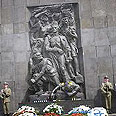
Warsaw ghetto memorial in Poland (archives)
צילום: לע"מ
Poland unveils memorial to Warsaw ghetto fighters
New monument honors last group of Jewish insurgents who escaped burning ghetto in May 1943
Polish officials unveiled a new monument Thursday honoring the last group of Jewish insurgents to escape from Warsaw's burning ghetto in 1943 as the Nazis crushed the revolt against their brutal rule.
It was a doomed struggle, but some managed to survive, and today the act of resistance stands as a source of pride for many Jews, especially in Israel. With the remaining ghetto population facing mass deportations to death camps, the insurgents rose up in April 1943 and managed to hold off the German army for nearly a month before being crushed.
The bronze memorial shows a sewage canal rising vertically from the ground with disembodied hands symbolically climbing their way to freedom. It honors insurgents who escaped the ghetto to the city's "Aryan" side through a stinking, dark and claustrophobic sewage canal.
The monument stands on Prosta Street where the last group of about 50 fighters emerged on May 10, 1943. The leader of that escape, Simha Rotem, today an 86-year-old Israeli, was honored by officials at the ceremony.
"We are here today to commemorate the heroic deed of a great Pole and a great Jew," Foreign Minister Radek Sikorski said. "We must remember that his heroism did not end in 1943. Together with several of his companions, he also took part a year later in the Warsaw Uprising," another ill-fated insurgency, that one by the entire city.
'We didn't stand a chance'
Rotem, whose nom de guerre was Kazik, remembered the uprising as "suicidal."
"We stood no chance; we were convinced that no one would survive this fight," Rotem said. However, after many days of "fighting against the Germans, it turned out that the majority of us were still breathing. In spite of impossible conditions, we were prepared to carry on with the fight, but we were threatened with being burned alive."
At that point, with the battle lost, Rotem said it was necessary to cross the besieged ghetto walls and "get out of this hell." He recalled that several attempts were unsuccessful before he led the final escape. The events are described in a book he has written, "Memoirs of a Warsaw Ghetto Fighter."
Sikorski said that Rotem "had limited contacts with the world outside the ghetto but nevertheless he managed to do something which seemed virtually impossible - to organize the transport and to contact the sewage workers, without whose cooperation covering those few kilometers (miles) in the sewage canal would have been impossible."
One of the monument's designers, architect Krzysztof Stefaniak, said the hands are meant to recall the drama of the fighters' escape as well as the "horror and scene of terror."










